
Saudi Arabia’s construction sector is driving Vision 2030, shaping cities, infrastructure, and industries at a massive scale. But cost overruns remain a major challenge: 75% of projects exceed budgets, with an average 15% increase due to mid-project changes, according to a 2023 Procore Technologies survey.
The Bill of Quantities (BoQ) helps address this challenge. It breaks a project into materials, labor, and costs, ensuring precise budgeting, transparent bidding, and better financial control. Some experts even argue that a construction project truly begins only once a BoQ is prepared.
In this article, we’ll explain what a BoQ is, its types, how to create one, and how to avoid common mistakes that can delay projects and inflate costs.
A Bill of Quantities (BoQ) is a detailed document that lists all materials, labor, and resources needed for a construction project. It’s usually prepared before hiring a contractor and serves as a key reference for bids.
Architects, engineers, or quantity surveyors create the BoQ to provide a clear breakdown of materials and labor, ensuring accurate cost estimation and project planning.
BoQ management is crucial for controlling budgets, verifying bid accuracy, and ensuring scope alignment. It also helps contractors estimate costs and profit margins, reducing disputes and enabling smoother project execution.
In Saudi Arabia, Vision 2030 highlights BoQ management as critical for mega-projects like NEOM, Qiddiya, and the Red Sea Project, as it:
Check out our detailed guide on Setting up of BoM. Knowing BOQ management is essential, but the way a BOQ is structured can vary greatly. Let’s explore the types.
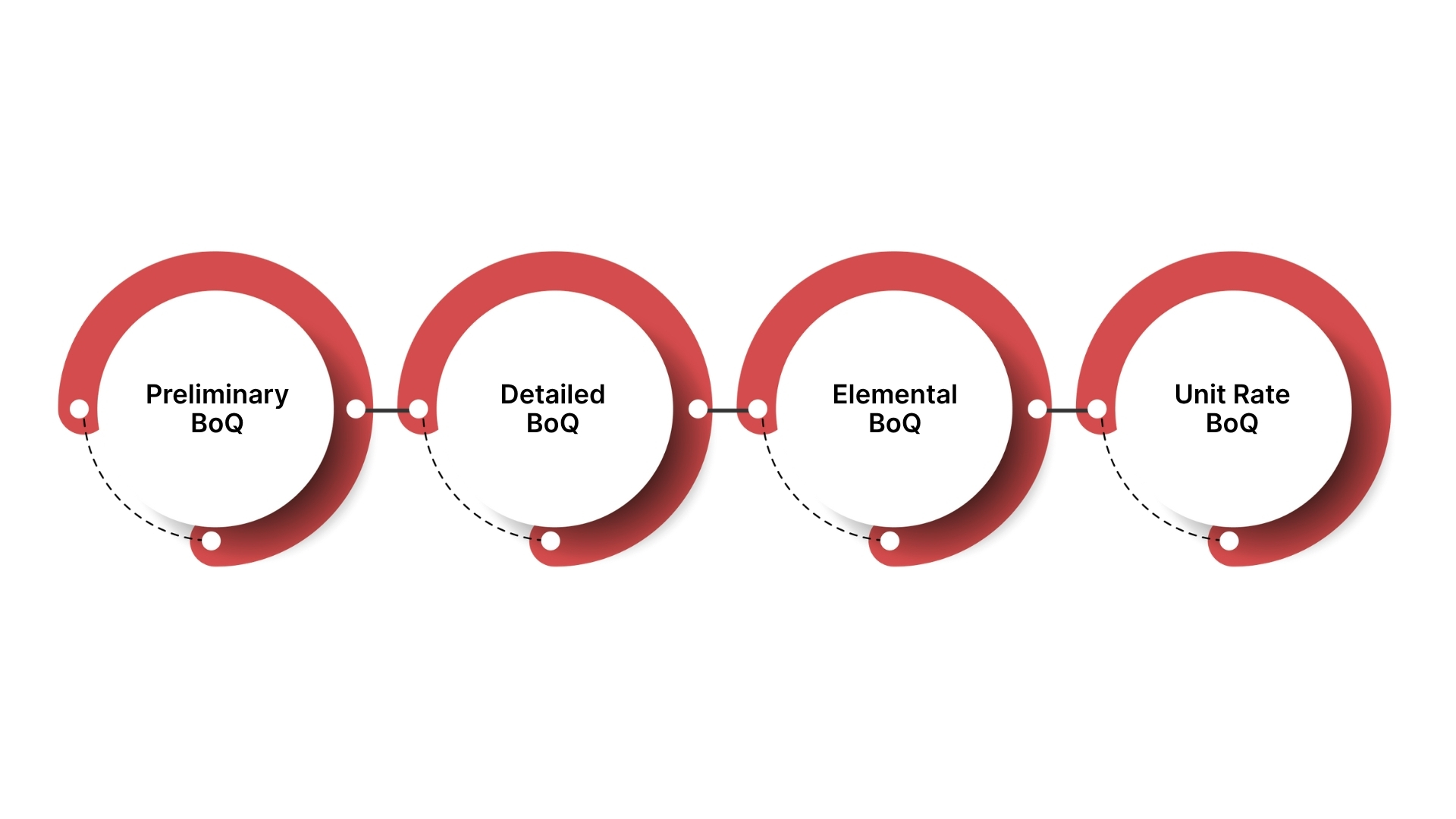
Although most common in construction, BoQs are also valuable in broader project management. Each type serves a specific purpose depending on the project’s stage, complexity, or cost estimation needs. Choosing the right type ensures better cost accuracy, reduces risks, and supports informed financial decisions.
While the different BOQ types help organize construction projects, there's often confusion with the Bill of Materials (BoM). Knowing how they differ prevents mistakes in planning and keeps project costs accurate.

A Bill of Quantities (BoQ) and a Bill of Materials (BoM) may look similar, but their purposes are very different.
A Bill of Materials (BoM) lists only the materials required to complete a project, aiding in cost estimation and resource planning. In contrast, a Bill of Quantities (BoQ) provides a detailed description of all the work needed to complete the project. Here’s how they differ:
Understanding this distinction is crucial for accurate cost management, resource planning, and avoiding confusion between construction and manufacturing. But a well-prepared Bill of Quantities (BOQ) is only useful if it includes all the essential information needed to plan, budget, and execute a project efficiently.
Also Read: Managing Cash Flow in Construction Projects
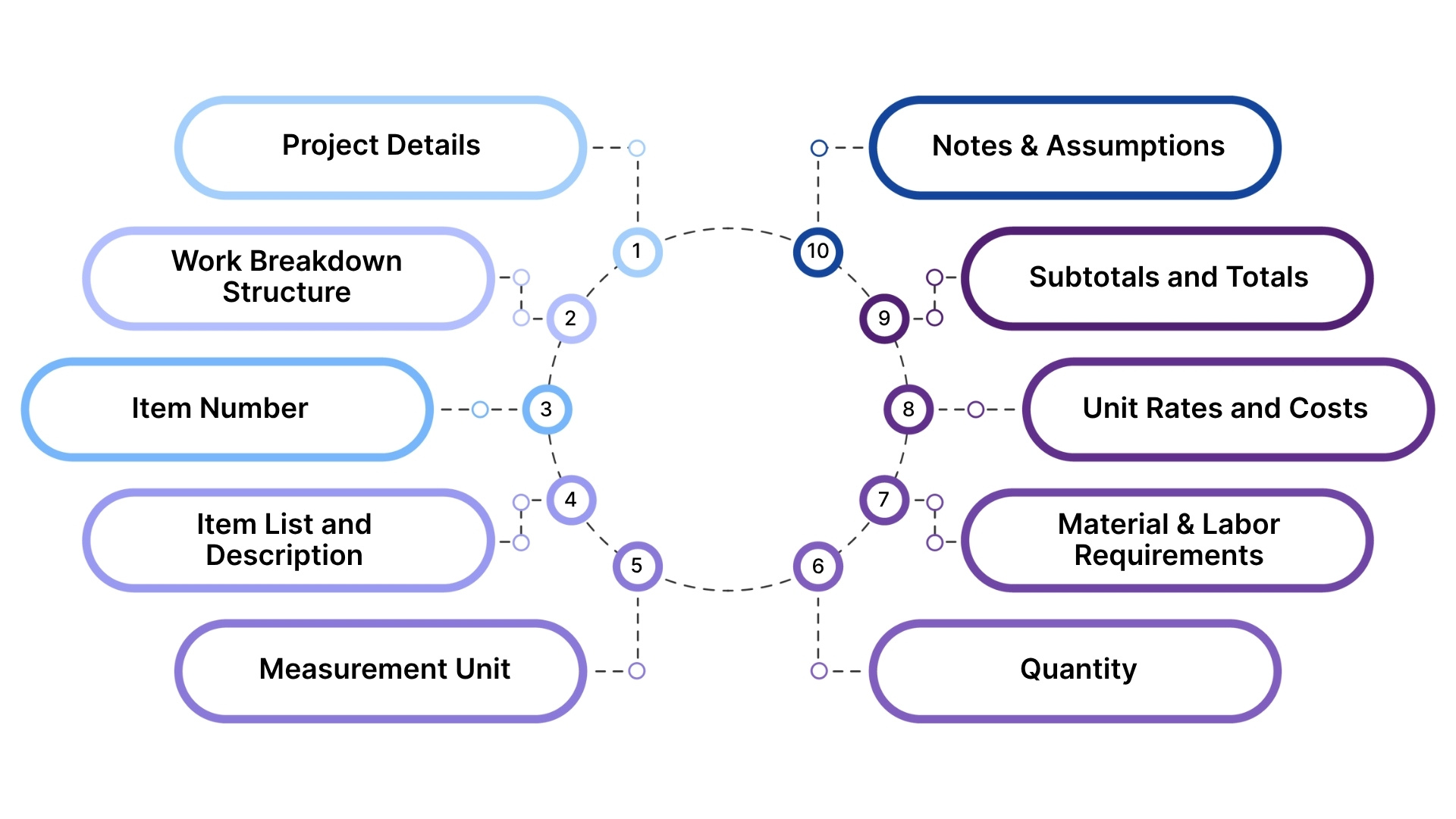
The main purpose of a BoQ is to provide accurate, organized information that supports budgeting, planning, and execution. While different types of BoQs exist, most include the following essential elements to ensure clarity, efficiency, and accountability:
1. Project Details: Begin with basic information such as project name, location, client, and timeline. This ensures all stakeholders know which project the BOQ refers to.
2. Work Breakdown Structure (WBS): Organize tasks and deliverables into a clear structure. The WBS provides a framework that helps ensure no work is overlooked and makes the BOQ easier to navigate.
3. Item Number: Assign a unique number to each item, whether labor or material. Numbering simplifies tracking, referencing, and cross-checking as the list grows.
4. Item List and Description: Clearly differentiate between materials and labor, providing detailed descriptions. For example, instead of “paint,” specify “exterior wall paint” to avoid confusion when multiple types are involved.
5. Measurement Unit: Define the unit for each item. Materials may be measured in kilograms, liters, or meters, while labor is usually measured in hours or days.
6. Quantity: Specify the amount required for each item. How many liters of paint? How many hours of labor? Accurate quantities are essential for budgeting, procurement, and scheduling.
7. Material and Labor Requirements: Include detailed requirements for materials and the type of labor needed. This ensures quality standards are met and helps forecast manpower and procurement needs efficiently.
8. Unit Rates and Costs: Assign unit rates for each material and labor item. Multiply the unit rate by the quantity to calculate total costs per line item, promoting transparency and enabling better budget control.
9. Subtotals and Totals: Include subtotals for each work section and a grand total for the project. This provides a clear overview of overall costs and supports financial planning.
10. Notes and Assumptions: Add any assumptions, exclusions, or special instructions. This prevents misunderstandings and ensures all parties have a clear understanding of the project scope.
By including these elements, your BoQ becomes a comprehensive, accurate, and actionable tool, helping control costs, reduce risks, and improve project efficiency. Let’s explore the key benefits and uses of a Bill of Quantities.

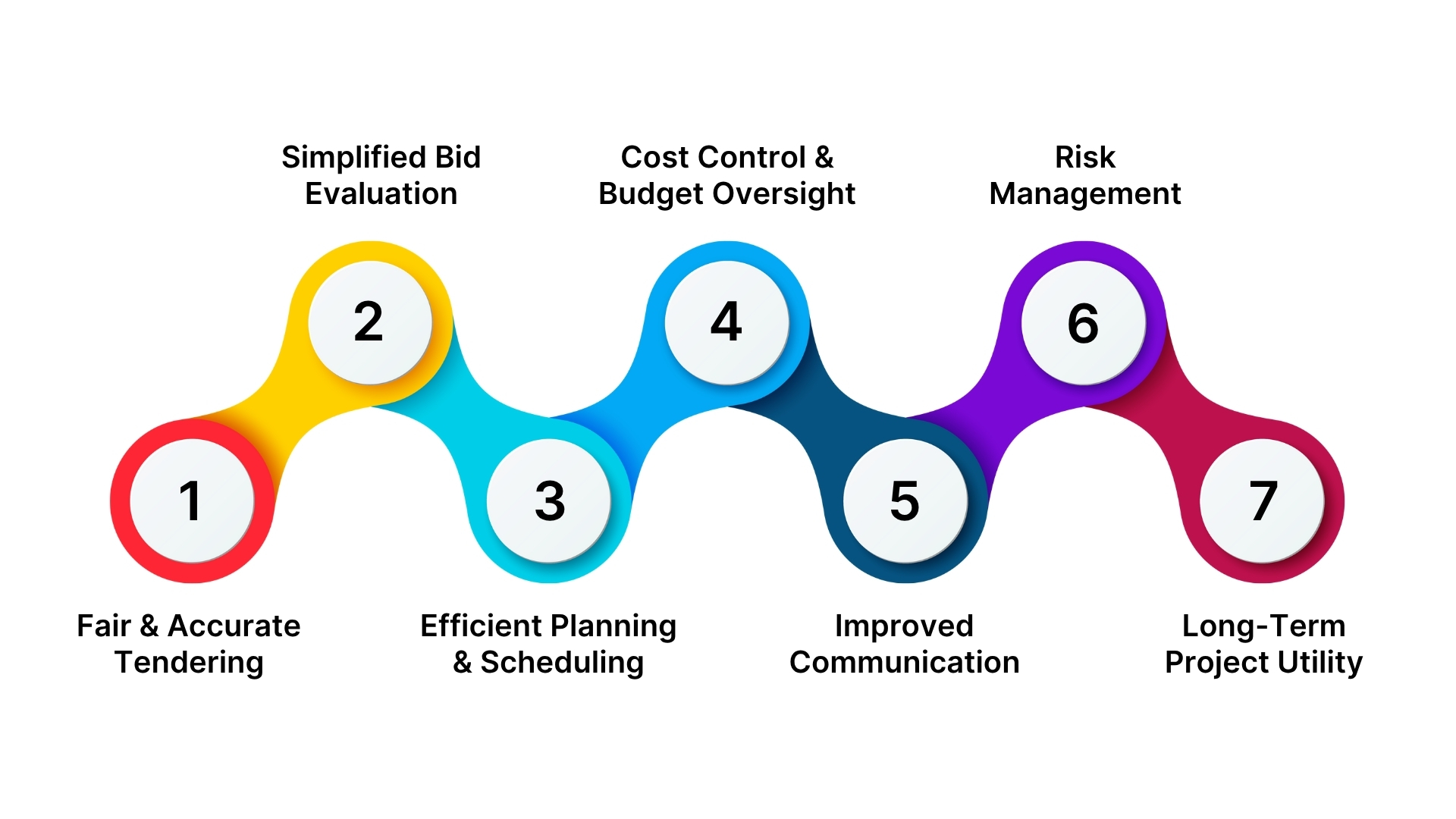
Errors in BoQs, such as incorrect quantities or outdated unit rates, are common causes of disputes and budget overruns in construction projects. A BoQ is more than a list of materials and labor; it’s a key tool for structure, transparency, and control throughout a project’s lifecycle.
Here's why it matters:
With these advantages in mind, the importance of BOQ management is undeniable. Let’s walk through the step-by-step process to prepare a reliable document.
Explore how HAL ERP solutions for construction can streamline BOQ processes and enhance cost control.
Also read: Cost Planning in Construction: Explore Key Benefits & Types
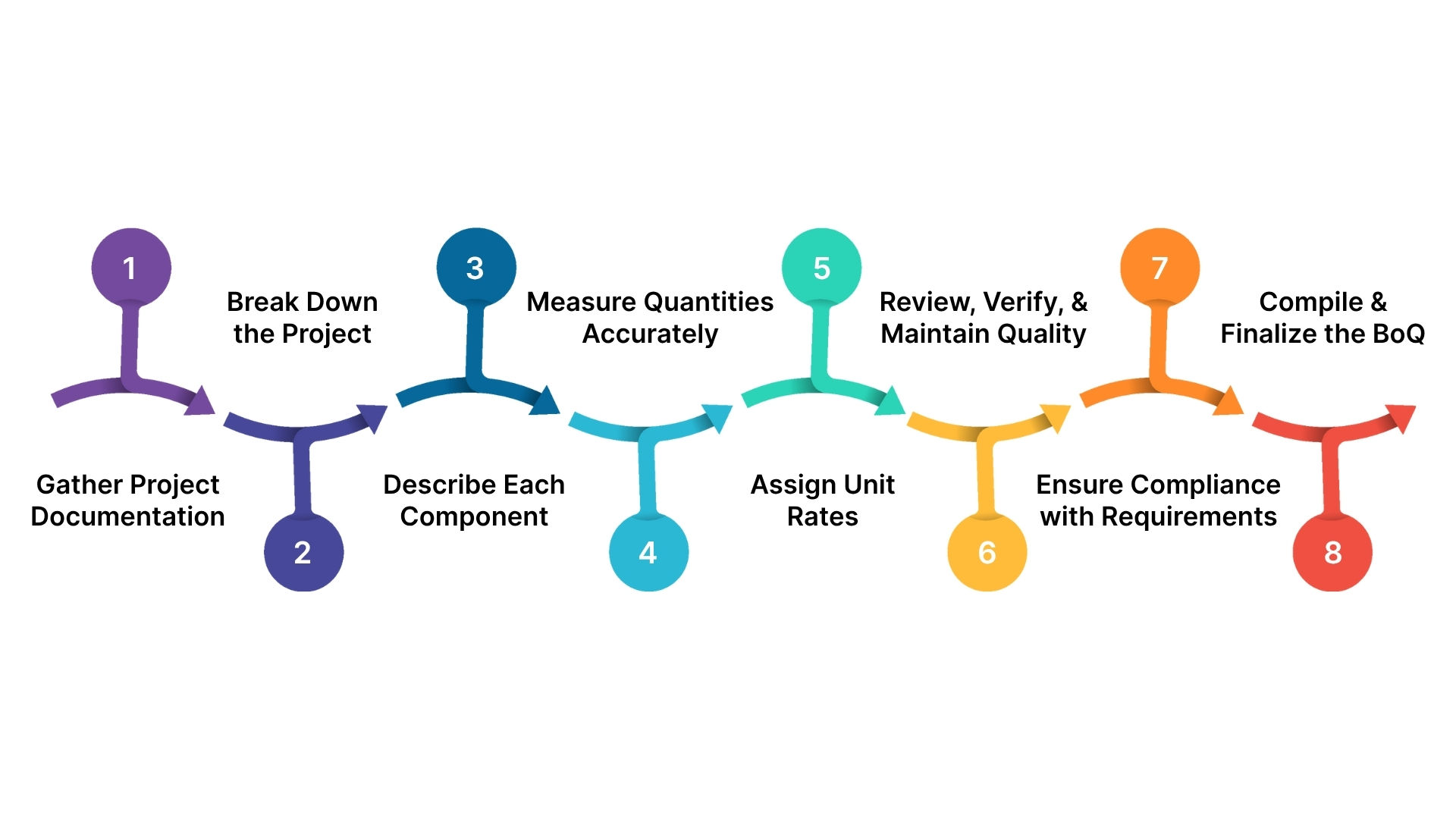
Preparing a Bill of Quantities (BoQ) requires precision, local compliance, and attention to detail. Here’s a structured process to create an accurate and reliable BoQ for your construction project in Saudi Arabia.
Use project drawings or BIM models to calculate quantities for every item. Accuracy here is non-negotiable; double-check measurements to prevent shortages or surpluses later. Using digital quantity takeoff tools or standardized methods of measurement can save time and reduce manual errors.
Organize the BoQ in a clear and logical format. Include:
For smaller projects, a single-sheet BoQ may suffice; for larger projects, structured Excel files with a master summary sheet are ideal. Integrate the BoQ with your project schedule and cash flow plan to align payments with progress.
A well-prepared BoQ ensures transparency, supports accurate budgeting, and keeps Saudi construction projects on schedule and within cost. Even with careful preparation, errors can creep in.
Also read: How to Create Effective Construction Progress Reports
Even experienced professionals can make errors when preparing a BoQ, and small mistakes can quickly lead to cost overruns, delays, or disputes. Understanding common pitfalls helps you create an accurate and reliable BoQ for Saudi construction projects.
Eliminating these errors early can save weeks of rework and thousands in additional costs. Consistently applying best practices transforms lessons learned into reliable, error-free BoQ management.
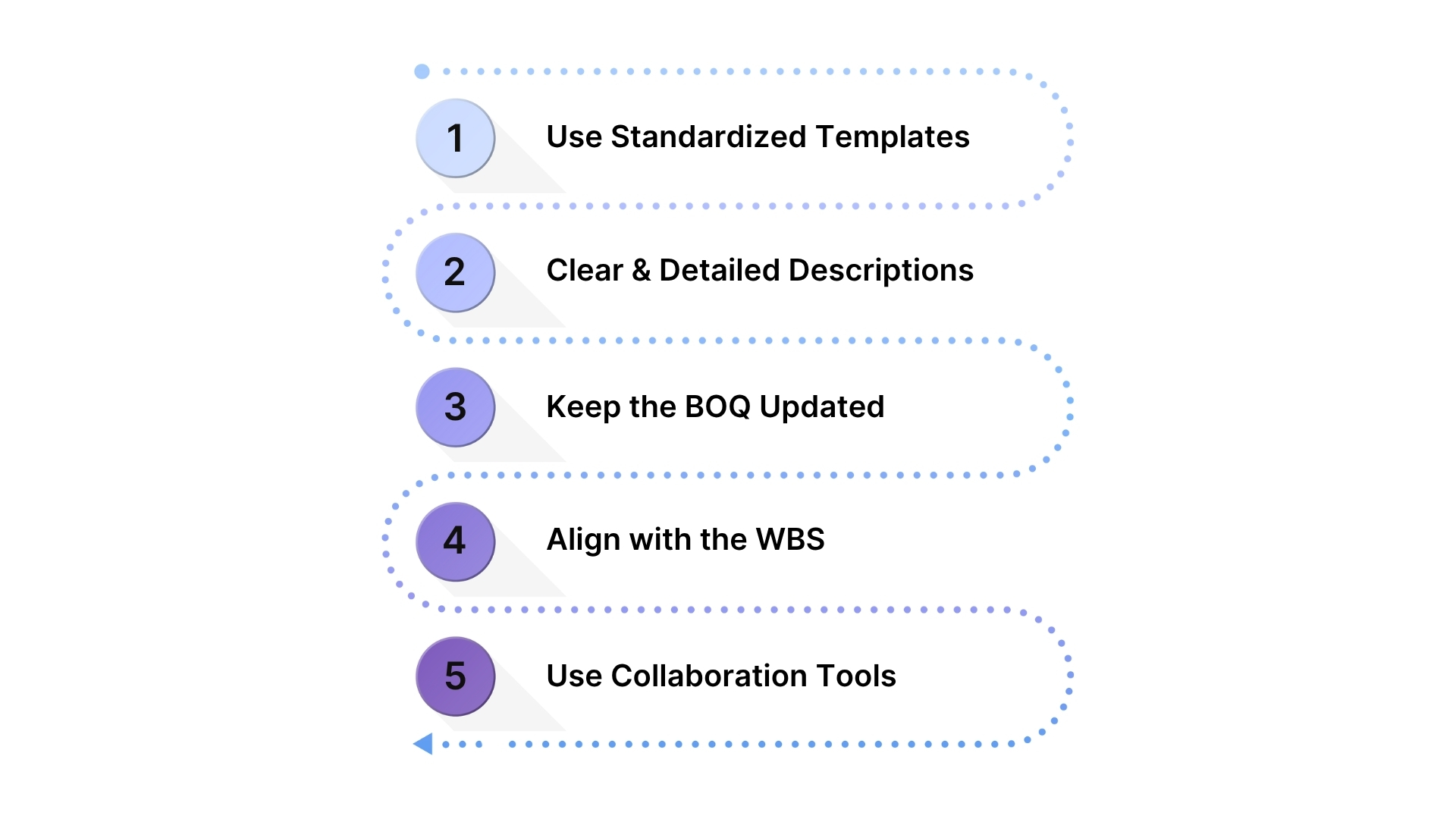
Creating an accurate BOQ requires attention to detail and adherence to best practices. Here's how you can ensure your BOQ serves its purpose effectively:
While these practices help improve accuracy, the truth is, manual BoQ preparation can only go so far. To manage complex projects and frequent design updates efficiently, you need technology that automates, tracks, and integrates every step of the process.

Manual methods leave too much room for human error and inefficiency. Technology bridges that gap by making BoQ management faster, more accurate, and transparent.
Specialized tools automate quantity calculations, apply consistent unit rates, and streamline document preparation. With features like customizable templates and real-time collaboration, teams can create precise BoQs in less time.
Cloud systems allow real-time access and version control, ensuring all stakeholders are working on the latest document. They also strengthen data security and simplify collaboration across multiple sites.
Analytics tools uncover patterns in cost trends, material usage, and project performance, helping teams make informed budgeting and procurement decisions.
Among the available tools, HAL ERP stands out by simplifying BoQ management and integrating it with financial workflows:
HAL ERP transforms BoQ management from a manual, error-prone task into a connected, intelligent workflow. It’s designed for construction companies of all sizes, from large enterprises to small businesses and startups, giving everyone access to accurate, real-time project control.
With HAL ERP, what was once a manual, error-prone process becomes a streamlined, efficient system, improving project accuracy, transparency, and profitability.
Al Faneyah, a leading Saudi construction and contracting firm, achieved a remarkable ROI of 900–1,150% within a year of implementing HAL ERP. The system unlocked an additional SAR 3.6–5.5 million annually by streamlining workflows, enhancing financial control, and automating routine tasks. This transformation enabled Al Faneyah to manage multiple projects more efficiently, reduce errors, and improve profitability, demonstrating HAL ERP's effectiveness for both large enterprises and small businesses in the construction sector.

Effective BOQ management is crucial for the success of your construction projects. It ensures accurate cost estimation, fair tendering, budget control, and smooth project execution. By following best practices, leveraging technology, and using HAL ERP, you can improve accuracy, efficiency, and financial oversight.
HAL ERP is a popular BOQ Software for Saudi Arabia Construction. It provides a complete solution to streamline BOQ processes, enhance project management, and optimize outcomes.
Take control of your construction costs and timelines. Request a Saudi-specific ERP demo!
1. What is BOQ management?
BOQ management involves creating, maintaining, and updating a Bill of Quantities to ensure accurate cost estimation, resource planning, and project budgeting throughout a construction project.
2. Who is responsible for creating a Bill of Quantities?
Typically, architects, engineers, or quantity surveyors prepare the BOQ to ensure accuracy and completeness for bidding, budgeting, and project planning.
3. What is the purpose of a BOQ?
A BOQ provides a detailed breakdown of materials, labor, and costs, enabling fair tendering, effective cost control, and smooth project execution.
4. How is BOQ calculated?
BOQ is calculated by listing all materials and labor, measuring quantities from project plans, and multiplying them by unit rates to estimate total costs.
5. What software is used for BOQ?
Common BOQ software for Saudi Arabia construction includes AutoCAD Quantity Takeoff, Microsoft Excel, CostX, PlanSwift, and HAL ERP solutions for accurate estimation and management.
6. What are the different types of BOQ?
The main types are Preliminary BOQ, Detailed BOQ, Elemental BOQ, and Unit Rate BOQ, each suited to different project stages and levels of detail.